1940-1949
1949 Cadillac
- Details
- Written by Big Block
- Category: 1940-1949
- Hits: 3835
1949 Cadillac
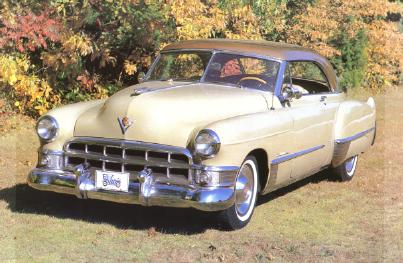 Having produced a blockbuster for 1948, no one expected much in the way of new excitement from Cadillac for the 1949 model year. They were wrong.
Having produced a blockbuster for 1948, no one expected much in the way of new excitement from Cadillac for the 1949 model year. They were wrong.
Shortly before the war, engineers at General Motors had realized that the old Cadillac V-8 needed to be replaced. Engineering was rapidly reaching the limits of what could be extracted from the reliable, but aging, L-head V-8 design. In fact, engineering had attempted a redo of the heads on the old engine to yield an 8.0:1 compression ratio. But the point of diminishing returns had been reached. Despite pushing the ratio this far, engineers saw no substantial increase in economy or performance, and there was a breathing loss. It was time to move on. 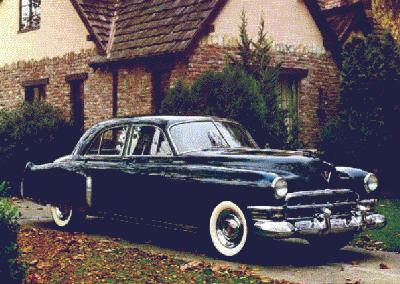 Ernest W. Seaholm, who had been in charge of Cadillac engineering for 20 years, came to this conclusion long before his retirement in 1943. Indeed, he had directed that work he started on a new power plant shortly before Pearl Harbor, but the ensuing war had halted progress on the new engine's development. After the war, the top engineers at GM, now under the direction of Harry F. Barr, Edward M. Cole, and John F. Gordon, tackled the problem. Their final creation set the pace for engine design and performance for years to come -- and it powered the 1949 Cadillac.
Ernest W. Seaholm, who had been in charge of Cadillac engineering for 20 years, came to this conclusion long before his retirement in 1943. Indeed, he had directed that work he started on a new power plant shortly before Pearl Harbor, but the ensuing war had halted progress on the new engine's development. After the war, the top engineers at GM, now under the direction of Harry F. Barr, Edward M. Cole, and John F. Gordon, tackled the problem. Their final creation set the pace for engine design and performance for years to come -- and it powered the 1949 Cadillac.
Not only did the new engine give the car unequalled performance and ability, but it did so at a substantial gain in fuel economy. The engine weighed in nearly 200 pounds less than the old L-head, but because it was cooler running it required less radiator mass, making the savings in weight even greater (220 pounds). Cadillac was able to offer all this, plus an engine which allowed for sleeker styling due to the fact that it was five inches shorter and four inches lower than the L-head. And even though the compression ratio was just 7.5:1, the new power plant was designed to take full advantage of higher-octane postwar fuels because it could tolerate a compression ratio of 12.0:1 or more. By 1948, 88-octane premium fuels were reaching the pumps, and higher octane’s were promised by the oil companies, so this was important in looking toward the future. So was the fact that there was ample block space for cylinder enlargement, and indeed displacement would be increased to 365 cubic inches in 1956. Also featured in the new V-8 were wedge-shaped combustion chambers and advanced "slipper" pistons. The latter, devised by Byron Ellis, traveled low between the crankshaft counterweights to permit short connecting rods and thus reduced reciprocating mass, meaning the engine could run more smoothly at higher rpm without undue wear or damage. 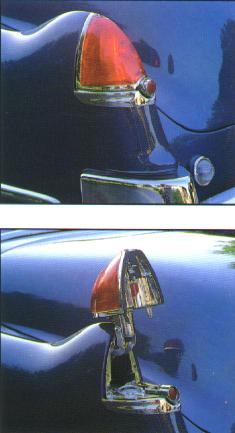 The engine was a sensation, so much so that it was rushed off to race tracks across the country. Almost-stock Caddy’s with big racing numbers plastered on their sides were seen roaring down race track straightaway’s within a few short months after the '49 models bowed. The cars were so hot that famed Briggs Cunningham took the Caddy’s racing, even to the 24 hours of Le Mans in France. There, a near-stock Coupe de Ville finished tenth overall against the world's finest racing machinery. The British Allard Company even used the engine in its new J-2 sports/racing car.
The engine was a sensation, so much so that it was rushed off to race tracks across the country. Almost-stock Caddy’s with big racing numbers plastered on their sides were seen roaring down race track straightaway’s within a few short months after the '49 models bowed. The cars were so hot that famed Briggs Cunningham took the Caddy’s racing, even to the 24 hours of Le Mans in France. There, a near-stock Coupe de Ville finished tenth overall against the world's finest racing machinery. The British Allard Company even used the engine in its new J-2 sports/racing car.
Out on the street, buyers could tell the difference, too. Though road test magazines were few in 1949, "Uncle" Tom McCahill reported in Mechanix Illustrated that "With this engine, Cadillac, despite its large size, out-performs just about every car being made." He backed that up by posting a 0-60-mph romp of 12.1 seconds (with stick shift) and a top speed of around 105 mph. No other car he tested that year did better. Author Hendry quoted slightly more conservative figures of 100 mph tops and 0-60 in 13.4 seconds. Either way, probably only the lighter-weight Olds 88 could keep up.
Introduction of the new engine helped erode a consumer problem Cadillac Division had faced since the close of the war. Cadillac had advertised heavily during World War II that M-5 and M-24 tanks were powered by Cadillac engines, so some consumers tried to get hold of the military engines and modify them for domestic use. Of course, such attempts at modification were more often than not fraught with a host of technical problems. Cadillac had tried every way it could to discourage such modifications, but it was the arrival of the new overhead V-8 that made the L-heads seem far less attractive.
In retrospect, the new Cadillac V-8 arrived on the scene just when it was needed. The L-head had served its era well, including the emergence of the automatic transmission. But now roads were getting better -- there were already a few limited-access roads and talk of many more to come -- and gasoline octane ratings were climbing. The new V-8, under constant development even after introduction, could handle these, so the first major redesign wasn't deemed necessary until 1964.
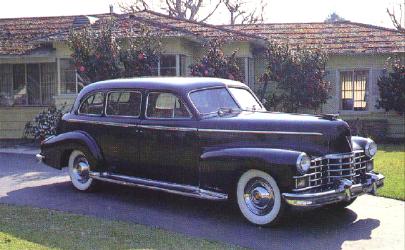
Sheet metal surfaces on the '49 Cadillac remained the same, except that the hood was made a bit longer. Shortly after production was underway a larger deck lid was phased in on notchback models. The grille, now with just one horizontal bar, was given bolder lines and the parking light housings wrapped around the fenders. The heavier grille on the '49 was the product of consensus between Earl and Hershey. Back when the '48 was being designed in Hershey's farmhouse, there wasn't enough space to get a full-size clay model of the car into the room, but there was room for a full-size mock-up of the front end. Earl had come by the farm every week or so to check on the progress the design team was making. During one of his visits he told Hershey that he wanted a delicate, almost jewel-like grille treatment. Hershey complied, and this "delicate" grille appeared on the '48. When it came time to do the '49 facelift, Earl asked Hershey if he really liked the delicate grille. Hershey said that he did not. Earl then suggested a heavier treatment, which became the '49 front end.
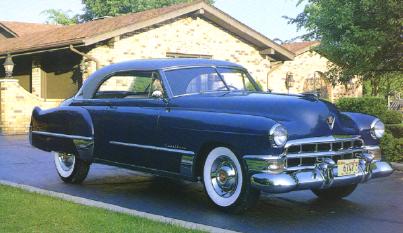
One quick way to tell a '48 Caddy from a '49 when seen from the rear is that the '48 had only one back-up light, while the '49 got two. Also, the '48 Series Sixty-Two models sported neat-looking triple horizontal chrome slashes between the taillights and bumper, but they were absent in 1949. 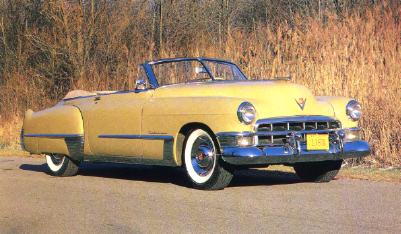 The story of the changes made inside the car for '49 paralleled that for the grille. Hershey found that he wasn't ecstatic about the "rainbow" dash. Thus, the large bulge over the instrument cluster which has endeared the '48 to so many automotive enthusiasts was replaced in the '49 model with a more conventional hooded horizontal speedometer. Critics have continually pointed out over the years that the 1948-49 interiors were rather bland for Cadillac, the '49 especially so. Others, as would be expected when dealing with matters of taste, exclaim over the richness and simple elegance displayed by the interiors of the two model years.
The story of the changes made inside the car for '49 paralleled that for the grille. Hershey found that he wasn't ecstatic about the "rainbow" dash. Thus, the large bulge over the instrument cluster which has endeared the '48 to so many automotive enthusiasts was replaced in the '49 model with a more conventional hooded horizontal speedometer. Critics have continually pointed out over the years that the 1948-49 interiors were rather bland for Cadillac, the '49 especially so. Others, as would be expected when dealing with matters of taste, exclaim over the richness and simple elegance displayed by the interiors of the two model years.
The formidable 136-inch-wheelbase, limited-production Series Seventy-Five remained much the same as it had been in 1946-48 except that it, too, was now powered by the new V-8. It might be noted that Cadillac had entered the decade with 10 distinct bodies and exited with only five, the loss coming at the expense of the Seventy-Five lineup. Explanation of the varied and often unexplainable tastes of automobile collectors would probably merit writing a book. For example, many collectors today prefer the '48 Series Seventy-Five models for the sole reason that they were powered by the faithful old L-head, despite the new engine's increased economy and efficiency.
One '49 Caddy much sought after by collectors is the Series Sixty-Two Coupe de Ville, a "hardtop convertible" introduced late in the model year. Though Cadillac had to share the honors with the Buick Riviera and Oldsmobile Holiday, this trio was the first to market this pillarless body style. The Coupe de Ville was basically a Series Sixty-Two convertible fitted out with a steel top, and featured a large wraparound three-piece rear window. Fitted out every bit as luxuriously as the ragtop, the Coupe de Ville even sported simulated top bows inside under the roof. That explains why the $3497 price tag was only $26 less than the ragtop's base price. Coupe de Ville output reached just 2150 units, but this new body style was destined to become all the rage in the Fifties.
Perhaps it's fitting, then, that when Cadillac produced its 1,000,000th car on November 25, 1949, it was the sporty Coupe de Ville that rolled off the Clark Street assembly line in Detroit. Though this milestone car was the last Cadillac of the Forties, it was in truth a car fully poised for the Fifties.
Also in November, Motor Trend magazine named its very first "Car of the Year." The field was narrowed down to three: Ford Oldsmobile, and Cadillac. Ford was eliminated first. Despite "an entirely new chassis and body, plus many mechanical changes," wrote auto journalist John Bond, "it offers nothing new or outstanding from an engineering viewpoint, since it now falls in line with conventional design practices established by competitors before the war. The Cadillac was chosen in preference to the Olds because, while both have outstanding new V-8 engines which are similar, they are not by any means the same. The Cadillac, with 10 per cent more piston displacement than the Olds, develops 18.5 per cent more bhp and weighs a few pounds less." In addition to the increased power of the new V-8, Bond cited "an even more important advantage" of greatly increased durability. He also pointed out that the new V-8 ". . . is brand new, and can normally be expected to be continued with little change for a period of at least seven years." In this regard, his assumption was certainly on the conservative side -- Cadillac doubled that time period. Incidentally, Motor Trend followed up the honors it bestowed on the '49 Cadillac by giving the similarly engineered '52 models, now up to 190 bhp and about 200 pounds heavier, its "Engineering Achievement Award."

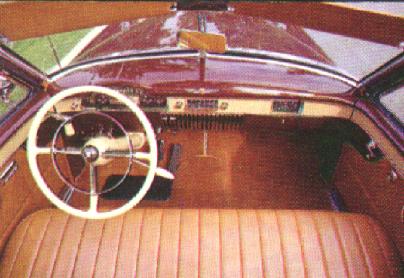
The 1948-49 Cadillac’s have also come in for latterday accolades. The Milestone Car Society, which honors the crème de la crème of postwar cars, has bestowed "Certified Milestone Car" status on the following models: Sixty-One Sedanet; Sixty-Two Sedanet, Convertible, and Coupe de Ville; Sixty Special; Seventy-Five Sedan/Limousine.
Cadillac Division could certainly take pride in the achievements of the Forties. And Franklin Q. Hershey could certainly take pride in the fact that he had finally been able to design production models of his first love -- Cadillac. In fact, with his development of the tailfins and the full-length flowing line, he had redefined Cadillac. And only about a million examples of the "Standard of Excellence" separated his last production Caddy from the first one his mother, Clara, had driven back in 1903!
| SERIES 61 |
The big news at Cadillac in 1949 centered on engineering, with the release of a new overhead valve V-8 engine. Only minor appearance changes were seen. They included a more massive grille treatment with grooved extension panels housing the front parking lights and chevron slashes below the tail lamps on Series 61 coupes. Once again, the cars in this line lacked front fender gravel shields and rocker panel moldings and had plainer interior trims. A larger luggage compartment lid was seen on all sedans, except very early production units. Standard equipment now included twin backup lamps mounted on the deck lid latch panel.
| I. D. NUMBERS |
- Cadillac serial numbers again matched motor numbers.
- They appeared stamped on a boss at the front right-hand face of the engine block and on the right frame side member behind the motor support.
- Motor serial numbers 496100000 to 496192552 were used on 1949 Series 61 models.
| Model Number | Body Style | Doors | Model | Seating | Factory Price | Shipping Weight | Production Total |
| 49-61 | 6169 | 4-door | Sedan | 5 | 2893 | 3915 | 15,738 |
| 49-61 | 6107 | 2-door | Club Coupe | 5 | 2788 | 3838 | 6,409 |
| 49-61 | - | - | Chassis only | - | - | - | 1 |
| ENGINE |
- V-8: Overhead valves.
- Cast iron block.
- Displacement: 331 cubic inches.
- Bore and stroke: 3-13/16 x 3-5/8 inches.
- Compression ratio: 7.50:1.
- Brake horsepower 160 @ 3800 rpm
- Five main bearings.
- Hydraulic valve lifters.
- Carburetor: Carter WCD two-barrel Models 682S or 722S.
| SERIES 62 |
The major difference between Series 61 and Series 62 models of similar body style was minor trim variations. The higher-priced series again had grooved, front fender stone shields and bright rocker panel moldings. Chevrons below the taillights were no longer seen. The convertible was an exclusive offering, as was a new pillarless two-door "convertible hardtop" called the Coupe DeVille. A more Deluxe interior was featured and power window lifts were standard on the convertible coupe and optional with other styles.
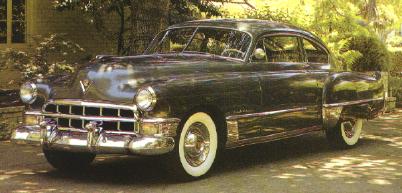
| ENGINE |
- V-8: Overhead valves.
- Cast iron block.
- Displacement: 331 cubic inches.
- Bore and stroke: 3-13/16 x 3-5/8 inches.
- Compression ratio: 7.50:1.
- Brake horsepower 160 @ 3800 rpm
- Five main bearings.
- Hydraulic valve lifters.
- Carburetor: Carter WCD two-barrel Models 682S or 722S.
| I. D. NUMBERS |
- Motor serial numbers 496200000 to 496292554 appeared on 1949 Series 62 models.
| Model Number | Body Style | Doors | Model | Seating | Factory Price | Shipping Weight | Production Total |
| 49-62 | 6269 | 4-door | Sedan | 5 | 3050 | 3956 | 37,617 |
| 49-62 | 6207 | 2-door | Club Coupe | 5 | 2966 | 3862 | 7,515 |
| 49-62 | 6237 | - | Coupe DeVille | 5 | 3496 | 4033 | 2,150 |
| 49-62 | 6267X | - | Convertible Coupe | 5 | 3497 | 4218 | 8,000 |
| 49-62 | 6269 | - | Export Sedan | - | 3050 | 3956 | 360 |
| 49-62 | - | - | Chassis only | - | - | - | 1 |
NOTE: The sedan for export was shipped in completely-knocked-down (CKD) form to foreign countries.
| ENGINE |
- V-8: Overhead valves.
- Cast iron block.
- Displacement: 331 cubic inches.
- Bore and stroke: 3-13/16 x 3-5/8 inches.
- Compression ratio: 7.50:1.
- Brake horsepower 160 @ 3800 rpm
- Five main bearings.
- Hydraulic valve lifters.
- Carburetor: Carter WCD two-barrel Models 682S or 722S.
| SERIES 60 SPECIAL FLEETWOOD |
| I. D. NUMBERS |
- Motor serial numbers 496000000 to 496088221 appeared on 1949 Series 60S Fleetwood models.
| Model Number | Body Style | Doors | Model | Seating | Factory Price | Shipping Weight | Production Total |
| 49-60S | 6069X | 4-door | Sedan | 5 | 3828 | 4129 | 11,399 |
| 49-60S | 6037X | - | Special Coupe DeVille | 5 | - | - | 1 |
| ENGINE |
- V-8: Overhead valves.
- Cast iron block.
- Displacement: 331 cubic inches.
- Bore and stroke: 3-13/16 x 3-5/8 inches.
- Compression ratio: 7.50:1.
- Brake horsepower 160 @ 3800 rpm
- Five main bearings.
- Hydraulic valve lifters.
- Carburetor: Carter WCD two-barrel Models 682S or 722S.
| SERIES 75 FLEETWOOD |
To accommodate luxury-class buyers, the long wheelbase Fleetwood models were carried over without any basic changes, except for revisions to the dashboard design which followed those on other models.
| I. D. NUMBERS |
- Motor serial numbers 497500000 to 497577135 appeared on 1949 Series 75 models.
| Model Number | Body Style | Doors | Model | Seating | Factory Price | Shipping Weight | Production Total |
| 49-75 | 7519X | 4-door | Sedan | 5 | 4750 | 4579 | 220 |
| 49-75 | 7523X | 4-door | Sedan | 7 | 4970 | 4626 | 595 |
| 49-75 | 7523L | 4-door | Business Sedan | 9 | 4650 | 4522 | 35 |
| 49-75 | 7533X | 4-door | Imperial Sedan | 7 | 5170 | 4648 | 626 |
| 49-75 | 7533L | 4-door | Business Imperial | 9 | 4839 | 4573 | 25 |
| 49-75 | - | - | Chassis only | - | - | - | 1 |
| 49-75 | - | - | Commercial chassis | - | - | - | 1,861 |
NOTE: The commercial chassis featured a 163 inch wheelbase and was offered to professional car makers for the construction of funeral vehicles, ambulances, etc.
| ENGINE |
- V-8: Overhead valves.
- Cast iron block.
- Displacement: 331 cubic inches.
- Bore and stroke: 3-13/16 x 3-5/8 inches.
- Compression ratio: 7.50:1.
- Brake horsepower 160 @ 3800 rpm
- Five main bearings.
- Hydraulic valve lifters.
- Carburetor: Carter WCD two-barrel Models 682S or 722S.
| CHASSIS |
| Model | Wheelbase | Overall Length | Front Tread | Rear Tread | Tires |
| Series 61 and 62 | 126 inches | 214 inches | 59 inches | 63 inches | 8.20 x 15 |
| Series 60S | 133 inches | 226 inches | 59 inches | 63 inches | 8.20 x 15 |
| Series 75 | 136 inches | 226 inches | 59 inches | 63 inches | 7.50 x 16 |
| POWER TRAIN OPTIONS |
- None available.
| CONVENIENCE OPTIONS |
- Hydra-matic transmission ($174).
- Whitewall tires.
- Radio and antenna.
- Heating and ventilating system.
- Chrome wheel discs.
- Fog lights.
- Safety spotlights.
- Other standard accessories.
| HISTORICAL |
The Milestone Car Society recognizes the following 1949 Cadillac’s as Milestone Cars:
- Series 61 coupe (sedanette);
- Series 62 coupe (sedanette);
- Series 62 convertible;
- Series 60 Special Fleetwood sedan.
1948 Cadillac
- Details
- Written by Big Block
- Category: 1940-1949
- Hits: 4321
1948 Cadillac
 The true postwar design history at Cadillac begins with the development of the 1948 model. As World War II drew to a close, there was a climate at Cadillac which had never existed before. Forces of unrest were afoot and a couple of key people, who might otherwise be relied upon to make important decisions, weren't even there.
The true postwar design history at Cadillac begins with the development of the 1948 model. As World War II drew to a close, there was a climate at Cadillac which had never existed before. Forces of unrest were afoot and a couple of key people, who might otherwise be relied upon to make important decisions, weren't even there.
The 1948-49 Cadillac was a dream come true -- the dream of a young boy way back in 1920. Years before that, the boy's Detroit socialite mother, Clara, had purchased the third Cadillac ever built, in 1903. Henry Leland, the husband of Clara's close friend and founder of Cadillac, had loaned his own chauffeur to teach her how to drive. Since that time, there had been a long succession of new Cadillac’s in the woman's life. The boy had thus literally grown up with Cadillac’s. 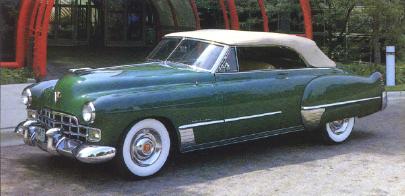 But there was something about Clara's 1918 phaeton that awakened in the boy a deep appreciation for a well-designed machine. When his mother sold the phaeton after moving to California, the boy was heartbroken. He began making sketches of it, and from there expanded into the creation of his own automobile designs. Promising himself that one day he would design a Cadillac, that boy grew up to be one of the most influential automobile designers of all time: Franklin Q. Hershey.
But there was something about Clara's 1918 phaeton that awakened in the boy a deep appreciation for a well-designed machine. When his mother sold the phaeton after moving to California, the boy was heartbroken. He began making sketches of it, and from there expanded into the creation of his own automobile designs. Promising himself that one day he would design a Cadillac, that boy grew up to be one of the most influential automobile designers of all time: Franklin Q. Hershey.
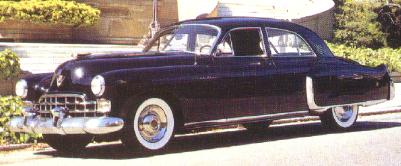
Hershey was initiated into the profession of automotive design at the Walter M. Murphy Body Company in Beverly Hills, California, where he created special automobile bodies for movie stars and millionaires. Later, he settled into a position with General Motors in Detroit. There, he developed a Bentley-style radiator for Pontiac, which quickly gained Hershey the recognition and support of Harley Earl, GM's design czar. That was followed by the famed Silver Streak Pontiacs -- a design theme that pulled the marque out of its commercial doldrums and became its trademark for two decades.
Upon his return from a stint in Germany, where he worked with GM's Opel Division, Hershey was made head of the General Motors Advanced Design Studio at 40 Milwaukee Avenue in Detroit.
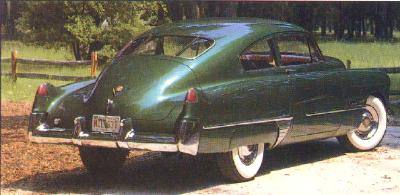
One day in the late Thirties, Earl received government permission through a friend to take some of his best designers to Michigan's Selfridge Field to see a secret military aircraft. Designers Bill Mitchell and Frank Hershey were among the group. Though no one knew it then, this field trip was destined to become legendary in the history of automotive design.
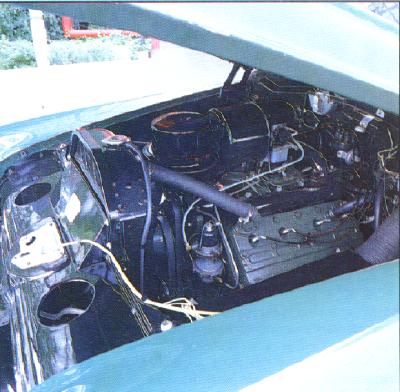
There on the runway, sat the thirteenth Lockheed P-38 Lightning, the twin-boomed aeronautical marvel that after some further development was going to set combat records in the coming war. Its radical design opened Mitchell's, and especially Hershey's, eyes to possibilities unthought-of of before -- they were transfixed by the elegance of the plane's design.
When the story of the '48 Cadillac is told, the influence of the plane's tailfins is usually the predominant theme. However the effect of the plane's design encompassed much more than that. Mitchell said, "You have to understand the value of what we saw in that plane's design. We saw that you could take one line and continue it from the cowl all the way back to the tip of the tail -- that you could have one unbroken, flowing line."
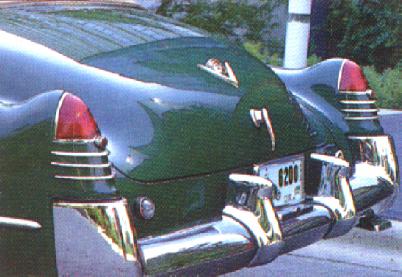
Hershey was also impressed with the plane's aerodynamic flow, but when he got back to his studio he began experimenting with the line of the tailfin he had seen. He worked with that idea, but both he and Mitchell moved on to other design projects before they left GM to serve in the Navy during World War II. Even so, meeting up with the P-38 Lightning had cast a spell over all the designers who had seen it. This spell would carry through the long war to the introduction of the 1948 Cadillac almost a decade later -- and beyond that into defining the design "flavor" of Cadillac’s for years thereafter.
Hall Hibbard and Kelly Johnson, the designers of the plane German fighter pilots would later label der Gabelschwanz -- the fork-tailed devil -- were quite modest about their influential design. The plane had evolved into its form because it had to accommodate two liquid-cooled GM Allison engines each with a General Electric turbocharger and Prestone radiators. Johnson was quoted in historian Bill Yenne's book on Lockheed that, "There was a reason for everything that went into it, a logical evolution. The shape took care of itself. In design, you are forced to develop unusual solutions to unusual problems." In other words, the plane's design followed the functional requirements the military had laid down to the designers. It is one of those interesting ironies of history that Cadillac Motor Division manufactured precision assemblies for the Allison engines used on the P-38 during the war. Cadillac even made limited use of this fact in its wartime advertising.

Hershey returned to GM in 1944, and Earl put him in charge of the Cadillac Design Studio. The war was winding down, so Cadillac had to be made ready for a return to non-military production. To set the record straight, Mitchell, who had headed Cadillac design before going into the military, didn't leave the Navy until about a year after Hershey. Even then, he didn't stay long at GM because he was asked to run a private design firm that Harley Earl had earlier started with his sons. Both the 1948 and '49 Cadillac’s had been designed before Mitchell eventually returned to GM
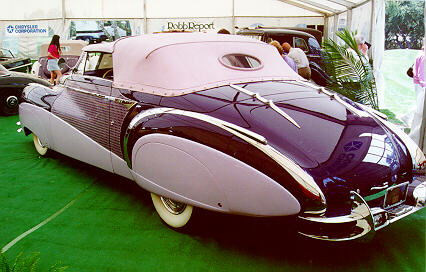 .
.
One other point must be made before continuing this story. In the late '30s, Earl had traveled the 40 miles to the University of Michigan in Ann Arbor to get a question answered. He wondered just what would be the optimum size for a less-than-full-size clay model of an automobile. Earl's motivation was to save time, money, and space -- but at the same time have his designers produce models that would give a true idea of a design concept's full-size appearance. The University's answer, after looking into the matter, was 3/8-scale.
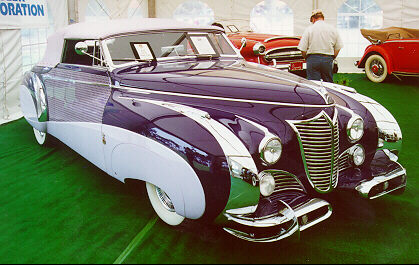

The "Interceptor" proposal was the first design series to make use of the 3/8-scale model concept and to incorporate some of the ideas developed from the visit to see the P-38 Lightning. Some of the models sported an early version of the tailfin, others did not. All of them, however, were based on the single line flowing from the leading edge of the vehicle to the rear bumper. Some of the Interceptor models were even triple-prowed like the P-38, and otherwise borrowed heavily from the plane's design.
Hershey remembers working on the clay models one day in the studio in the GM engineering building and adding tailfins to a particular model of that series. When Earl came in with Nick Dreystadt, one of the top executives, he saw them and told Hershey, "Take those things off!" Being the rugged individualist that he was, Hershey left the fins on and simply covered them with a drape. Earl came back a couple days later and said the same thing: "I told you to take those things off!" Hershey just covered the fins again.
Some time later, Dreystadt came into the studio, looked at the model, and said, "Thank God, you left the fins on the car! The top brass loves them!" Earl then encouraged Hershey to leave the fins on the models wherever he wished. Tailfins had gained a secure foothold in Cadillac design.
The Interceptor series was an interesting offshoot of Cadillac styling that was never introduced to the public. Actually, two full-sized running versions of the Interceptor concept were built shortly after the war. Partly due to their aerodynamic design, their performance on the GM test track was spectacular, Hershey remembers. The engineers were especially impressed.
The problem was that when top management looked closely at the cars, they finally concluded that their design was just too advanced for the public. Harley Earl had once said, "A fundamental we have learned ... is not to step too far at a time; but every now and then we take a risk." To bring the Interceptor to production was deemed too great a risk. The Interceptor design concept thus went no further than the two prototypes that had been driven on the GM test track. Finally, they too were broken up.
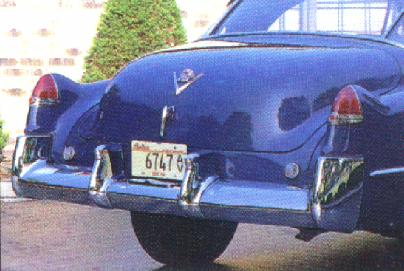
The sad fact is that the Interceptor might well have become the 1948 Cadillac, but the design was judged to be too far ahead of its time. Earl therefore directed Hershey, as the head of Cadillac Design, to take a new tack -- to start over. Because the 1946 and '47 Caddy’s had been rehashes of the '41 and '42, it was concluded that Cadillac needed a fresh new beginning, one that would reinforce its leadership position of excellence of design.
At this crucial point, a significant event occurred. There was labor trouble at GM and elsewhere in Detroit in the early postwar years, for that matter -- effectively locking the design team out of its studio. During the work on the Interceptor, however, Hershey had bought a 60-acre farm about 30 miles outside Detroit to be near the General Motors test track. In light of the lockout, he decided to move the Cadillac design team -- including his master clay sculptor, Chris Kline -- out to the farmhouse to continue design work in the basement. One of the guys even made a sign proclaiming this to be the Cadillac Design Studio (although the official designation of the team was "Special Car Design Studio"). Fortunately, there was much camaraderie in this makeshift facility -- and even more hard work.
Thus did Hershey's farmhouse become the birthplace of the befinned 1948 Cadillac. Franklin Q. Hershey, the man who just seven years later would give us the classic two-seater Ford Thunderbird, was also the man who gave us the '48 Caddy -- his boyhood dream of designing a Cadillac had come true. But it was more than that, for the '48 would set a design standard that would influence Cadillac for years.
When most car buffs talk fins, they have a specific treatment in mind and point to the '48 Cadillac as having the first. However, Bill Mitchell claimed that, strictly speaking, the '48 was not exactly the first year for Cadillac tailfins. For example, he said, you can look at the 1937 Fleetwood Series Seventy-Five convertible sedan and see that there was a "fin-like" projection on the rear fender -- even though that projection was fully chromed and was obviously a separate and distinct lamp housing attached to the fender.
But true fins are a sweep of the fender itself; sometimes the taillight is housed within it, sometimes not. The success of the '48 Cadillac tailfin was how Hershey incorporated what Mitchell himself learned from the '38: The fin was a continuation of the flow of the bodyline from the front to the rear of the car. It was as simple and as elegant as that, but Hershey alone had the talent and insight to put it together.
The '48 Cadillac was an instant success with buyers. When dealers first saw it, however, they were apprehensive, and some were downright scared the public wouldn't like it. But any negative opinions the dealers had were soon overshadowed by the public's instant and massive demand for the car. The '48 was the spirit of the P-38 Lightning on wheels -- and it was there to be bought in any Cadillac showroom. With that beautiful line flowing through the body panels, climaxing in the elegant tailfins that gave the effect of making the car look longer, the sheer beauty and simplicity of the car's body took many an onlooker's breath away. The rounded bumpers and curved windshield only added to the car's sleek styling. In 1948, Cadillac was the luxury car to own.
Everyone wanted to copy the Caddy in whatever way they could. Mail order houses did a brisk business selling tailfins that could be mounted on the rear fenders of Fords or Chevys. Design studios around the world adopted various forms of the fin for whatever car was being face lifted. Eventually one could see fins on everything from the Henry J to a Mercedes.
Even the grille of the '48 was new, although it continued the distinctive wide cross-hatch theme. A delicate bow of chrome defined the top line of the grille, while the two inside horizontal bars ran outboard to become the upper and lower borders of the parking lights. The forward-sloping hood provided greater visibility, enhancing the low lines of the car, while the front fenders blended smoothly into the body sides, becoming an integral part of the bodywork (rather than being "tacked on").
In spite of its fresh new look, the '48 Cadillac maintained much that was distinctive of the marque. The name in script, the goddess on the hood, "V" emblem with crest up front, egg crate grille, massive "sombrero" wheel covers, distinctive body moldings, hardware and mascots by Chris Kline, and embryonic "Dagmar" bumper guards all shouted "Cadillac" loud and clear.
The Series Sixty-One and Sixty-Two, actually a bit shorter than the same models of the previous year, each offered a two-door fastback club coupe, or "Sedanet." The almost-a-boat tail coupes of 1948-49 were arguably the most beautiful postwar fastbacks ever built. The Sixty-Ones and Sixty-Twos differed only slightly in trim -- no chrome rocker panel moldings or front fender stone shields for the Sixty-One, for example -- but shared the same sheet metal and 126-inch wheelbase. Hershey had indeed wrought some magic, because the two-inch-narrower cars were two inches wider inside, where buyers really appreciated it.
The limited-production Fleetwood Series Seventy-Five conservatively carried on with the '46 sheet metal, amortizing the prewar 1941-42 dies used in the manufacture of this impressive 136-inch-long-wheelbase vehicle. Available in models which carried five people, to the nine-passenger Imperial, the Seventy-Fives were luxuriously finished both inside and out, striking awe into those who witnessed one lumbering down the boulevards of postwar America.
The design flagship of the line was the Sixty Special -- the cream of the '48 lineup. Hershey points out that the treatment of the stone guards ahead of the rear wheels on this model was a direct carry-over from the Prestone side radiators situated to the rear of the twin booms of the P-38. This inspired chrome treatment, the distinctive set of five chromed hashmark strips on the sail panel, the more elegant interior, and longer 133-inch wheelbase made the Sixty Special a much desired automobile, as it is even today.
Though retaining a narrow center pillar, the two-piece windshield on all models except the Seventy-Fives was curved, quite a novelty in 1948. And because the various models differed in height, Cadillac had to produce four different windshields for the model year.
Inside the '48, instruments were clustered quite functionally in a deep pod under the dashboard line that carried through almost to the floor on both sides. Some automotive enthusiasts have called this a "rainbow" instrument panel because of its generous sweep. Functional ducts in the front doors circulated air to the side windows and the windshield, a forward-looking feature at the time.
Despite all the new styling features, the 150-horsepower L-head V-8 and Hydra-Matic automatic transmission were carried over virtually unchanged from 1941-47. The V-8 was tough, with a distinguished record for smoothness and longevity, and as good or better than anything offered by the competition. On the minus side, it was bulky and heavy. Maurice D. Hendry, in Cadillac, Standard of the World: The Complete History, described the engine's performance and economy as "adequate." The figures quoted were a top speed of 93.3 miles per hour, 0-60 mph in 16.3 seconds, and fuel economy of 14 miles per gallon at 60 mph (all figures with Hydra-Matic).
The '48 Caddy didn't get into production until late February 1948, and went on sale in dealer showrooms in March. The model year thus spanned a short nine months. Demand was higher than supply, but there was only time to build 52,706 cars for the '48 model run.
Major design changes marked the short wheelbase Cadillac’s (series 61) for 1948.
- They featured General Motors first all-new postwar body with styling advances including tailfins inspired by the Lockheed P-38 fighter plane.
- There was also an attractive egg crate grille which was higher in the middle than on the sides.
- The front of the car was protected by a heavier and more massive bumper bar which curved around the fenders.
- The Cadillac crest was centered low in a 'V' above the radiator grille.
- Chrome headlamp rims were used.
- Cars in the 61 series lacked bright metal front fender shields and under-taillight trim.
- A new dashboard with "rainbow" style instrument cluster and leather grained panels extending to the carpets were seen only this year.
| I. D. NUMBERS |
- Cadillac serial numbers again matched motor numbers and were used for all license, insurance and identification purposes.
- They were placed in the same locations as before.
- Motor serial numbers 48100001 to 486148663 appeared on 1948 Series 61 models.
| Model Number | Body Style | Doors | Model | Seating | Factory Price | Shipping Weight | Production Total |
| 48-61 | 6169 | 4-door | Sedan | 5 | 2833 | 4150 | 5,081 |
| 48-61 | 6107 | 2-door | Club Coupe | 5 | 2728 | 4068 | 3,521 |
| 48-61 | - | - | Chassis only | - | - | - | 1 |
| ENGINE |
- V-8 L-head.
- Cast iron block.
- Displacement: 346 cubic inches.
- Bore and stroke: 3-1/2 x 4-1/2 inches.
- Compression ratio: 7.25:1.
- Brake horsepower: 150 at 3400 rpm
- Three main bearings.
- Hydraulic valve lifters.
- Carburetor: Carter WCD two-barrel (models 595S or 595SA) or Stromberg AAV-26 two-barrel (models 380154 or 380871).
The Series 62 was now on the same wheelbase as the lowest priced line making the club coupe and sedan practically identical to similar models in the Series 61 range, except for trim and appointments. Distinguishing features included grooved, bright metal front fender gravel guards, rocker panel bright work, chevron style chrome slashes below taillights and slightly richer interior trim. The convertible coupe was an exclusive offering in this line.
| I. D. NUMBERS |
- Motor serial numbers 486200001 to 486252704 appeared on 1948 Series 62 models.
| Model Number | Body Style | Doors | Model | Seating | Factory Price | Shipping Weight | Production Total |
| 48-62 | 6269 | 4-door | Sedan | 5 | 2996 | 4179 | 23,997 |
| 48-62 | 6207 | 2-door | Club Coupe | 5 | 2912 | 4125 | 4,764 |
| 48-62 | 6267 | - | Convertible Coupe | 5 | 3442 | 4449 | 5,450 |
| 48-62 | - | - | Chassis only | - | - | - | 2 |
| ENGINE |
- V-8 L-head.
- Cast iron block.
- Displacement: 346 cubic inches.
- Bore and stroke: 3-1/2 x 4-1/2 inches.
- Compression ratio: 7.25:1.
- Brake horsepower: 150 at 3400 rpm
- Three main bearings.
- Hydraulic valve lifters.
- Carburetor: Carter WCD two-barrel (models 595S or 595SA) or Stromberg AAV-26 two-barrel (models 380154 or 380871).
The Series 60 Special Fleetwood sedan was again based on an extended General Motors C-Body shell with two-inch wider front and rear doors. The tailfins, built-in rear bumper design and egg crate grille seen on the lower-priced lines were used. Appearing again, on the rear roof pillar, were four slanting chrome slashes. Instead of the standard wide stone shields, the 60 Special had a thinner type which curved upwards along the forward contour of the rear fender and incorporated an attractive ribbed insert panel. At the rear of the car, a band of chrome extended across the bottom of the fender skirts and quarter panels. Standard equipment included cloth and leather upholstery combinations and leather-grained doors and instrument panel.
| I. D. NUMBERS |
- Motor serial numbers 486000001 to 486052706 appeared on 1948 Series 60S Fleetwood models.
| Model Number | Body Style | Doors | Model | Seating | Factory Price | Shipping Weight | Production Total |
| 48-60S | 6069 | 4-door | Sedan | 6 | 3820 | 4356 | 6,561 |
| ENGINE |
- V-8 L-head.
- Cast iron block.
- Displacement: 346 cubic inches.
- Bore and stroke: 3-1/2 x 4-1/2 inches.
- Compression ratio: 7.25:1.
- Brake horsepower: 150 at 3400 rpm
- Three main bearings.
- Hydraulic valve lifters.
- Carburetor: Carter WCD two-barrel (models 595S or 595SA) or Stromberg AAV-26 two-barrel (models 380154 or 380871).
On the Series 75 Fleetwood, consideration was given to the deletion of the long-wheelbase line this year, but competitive pressures from Packard in the luxury class market dictated the retention of these models. Again, they featured General Motors' old fashioned "Turret Top" styling, a throwback to the pre-war years. Minor revisions on the outside of the cars included a new background for the V-shaped hood emblem and Cadillac scripts -- replacing block lettering -- low on the fenders behind the front wheel opening. Buyers ordering fog lamps got rectangular parking lamps in place of the smaller round style. Stainless steel running boards were seen once more and the 75s also had the new dashboard treatment, but with burled leather trim.
| I. D. NUMBERS |
- Motor serial numbers 487500001 to 487546088 appeared on 1948 Series 75 Fleetwood models.
| Model Number | Body Style | Doors | Model | Seating | Factory Price | Shipping Weight | Production Total |
| 48-75 | 7519X | 4-door | Sedan | 5 | 4779 | 4875 | 225 |
| 48-75 | 7523X | 4-door | Sedan | 7 | 4999 | 4878 | 499 |
| 48-75 | 7523L | 4-door | Business Sedan | 9 | 4679 | 4780 | 90 |
| 48-75 | 7533X | 4-door | Imperial Sedan | 7 | 5199 | 4959 | 382 |
| 48-75 | 7533L | 4-door | Business Imperial | 9 | 4868 | 4839 | 64 |
| 48-75 | - | - | Chassis only | - | - | - | 2 |
NOTE: The commercial chassis featured a 163 inch wheelbase.
| ENGINE |
- V-8 L-head.
- Cast iron block.
- Displacement: 346 cubic inches.
- Bore and stroke: 3-1/2 x 4-1/2 inches.
- Compression ratio: 7.25:1.
- Brake horsepower: 150 at 3400 rpm
- Three main bearings.
- Hydraulic valve lifters.
- Carburetor: Carter WCD two-barrel (models 595S or 595SA) or Stromberg AAV-26 two-barrel (models 380154 or 380871).
| CHASSIS |
| Model | Wheelbase | Overall length | Front Tread | Rear Tread | Tires |
| Series 61 and 62 | 126 inches | 214 inches | 59 inches | 63 inches | 8.20 x 15 |
| Series 60S | 133 inches | 226 inches | 59 inches | 63 inches | 8.20 x 15 |
| Series 75 | 136 inches | 226 inches | 59 inches | 63 inches | 7.50 x 16 |
| POWER TRAIN OPTIONS |
- None available.
| CONVENIENCE OPTIONS |
- Hydra-Matic transmission ($174).
- Whitewall tires
- Radio and antenna.
- Fog lamps.
- Safety spotlight.
- Rear window defroster.
- And more.
| HISTORICAL |
- Division windows between front and rear seats were available on some Fleetwood models for limousine use.
- Commercial and business chassis were supplied to professional carmakers.
- The Classic Car Club of American recognizes all 1948 Series 75 models as Classic Cars.
- The following models are recognized as Milestones by the Milestone Car Society:
- Series 61 coupe (sedanette);
- Series 62 coupe (sedanette);
- Series 62 convertible;
- Series 60S Fleetwood Special sedan.
1947 Cadillac
- Details
- Written by Big Block
- Category: 1940-1949
- Hits: 3207
1947 Cadillac
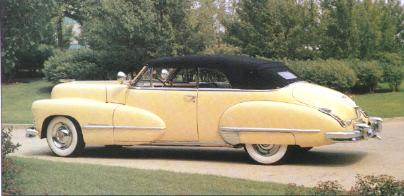 Although there was little change from '46, the quickest way to distinguish a '47 was the Cadillac name written in script on the front fenders. And while Spartan rubber stone guards had been used on the leading edge of the rear fenders for '46, they were made of stainless steel in 1947. A full wheel cover, which came to be called the "sombrero" because of its size and shape, replaced the diminutive standard '46 hubcap. The housings for the fog lamps and parking lights were combined for '47 and one of the horizontal bars of the grille was eliminated. The trunk emblem, meanwhile, sprouted LaSalle-like wings (except on the Sixty Special). Overall, the effect of the '47 styling was a bit more "Cadillac" than in 1946.
Although there was little change from '46, the quickest way to distinguish a '47 was the Cadillac name written in script on the front fenders. And while Spartan rubber stone guards had been used on the leading edge of the rear fenders for '46, they were made of stainless steel in 1947. A full wheel cover, which came to be called the "sombrero" because of its size and shape, replaced the diminutive standard '46 hubcap. The housings for the fog lamps and parking lights were combined for '47 and one of the horizontal bars of the grille was eliminated. The trunk emblem, meanwhile, sprouted LaSalle-like wings (except on the Sixty Special). Overall, the effect of the '47 styling was a bit more "Cadillac" than in 1946. 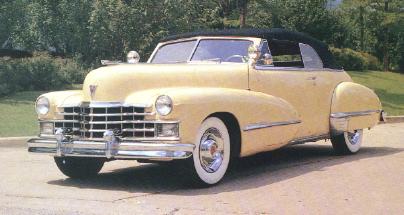 Mechanically, the '47 engine was toughened with hardened ball seats as a component of the hydraulic valve lifters. Cadillac considered this improvement important enough to phase it in on the late '46s. Sixty-Two convertibles and the Seventy-Fives were now equipped with Hydro-Lectric window lifts as standard equipment. This was a complicated hydraulic system that requires careful attention to long-term maintenance for the collector who owns a Cadillac so fitted.
Mechanically, the '47 engine was toughened with hardened ball seats as a component of the hydraulic valve lifters. Cadillac considered this improvement important enough to phase it in on the late '46s. Sixty-Two convertibles and the Seventy-Fives were now equipped with Hydro-Lectric window lifts as standard equipment. This was a complicated hydraulic system that requires careful attention to long-term maintenance for the collector who owns a Cadillac so fitted.  By the end of the 1947 model year, Cadillac was back on its peacetime track. The number of cars produced reached 61,926 units, more than twice that of '46. And while Packard had regularly out produced Cadillac in the prewar years (largely on the strength of its junior cars), and edged out Cadillac by 1579 units for '46, Cadillac beat Packard by a solid 10,840 units in 1947. Packard would enjoy an edge again in 1948 and '49, while Cadillac was tooling up its new postwar styling and sensational overhead-valve V-8.
By the end of the 1947 model year, Cadillac was back on its peacetime track. The number of cars produced reached 61,926 units, more than twice that of '46. And while Packard had regularly out produced Cadillac in the prewar years (largely on the strength of its junior cars), and edged out Cadillac by 1579 units for '46, Cadillac beat Packard by a solid 10,840 units in 1947. Packard would enjoy an edge again in 1948 and '49, while Cadillac was tooling up its new postwar styling and sensational overhead-valve V-8.
But when Cadillac showed up for 1950 with new styling again, it left Packard in the dust, never to look back again. The "Standard of the World" reigned supreme in America, and it wasn't until the late Eighties that Cadillac would again face a formidable domestic competitor, this time Lincoln.
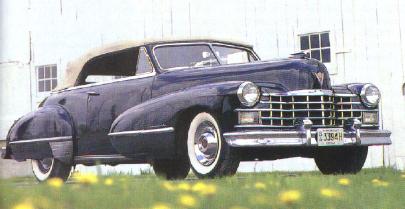
But during the Forties, Cadillac not only consolidated its engine and model offerings, but it also managed by decade's end to consolidate its hold on the luxury car market. And it did this by giving its owners a "Rich Reward": quality, style, and performance.

A minor styling facelift characterized 1947 Series 61 Cadillac’s, which now had grilles with five massive horizontal blades instead of the six used the previous year. A new identification feature was a striped field for the V-shaped hood crest. Sombrero style wheel covers were an attractive new option seen on many Cadillac’s. In the logo, department, a script type nameplate replaced the block lettering used on the sides of front fenders in 1946. Upholstery and paint combinations were generally revised and steering wheel horn rings were changed to a semicircular design. The old style rubber stone shields were replaced with a bright metal type and a new winged trunk ornament was used on all models except the Series 60 Fleetwood Special sedan. Other features were basically unchanged over last year's cars. The Series 61 models continued to utilize the GM B-Body with fastback styling.
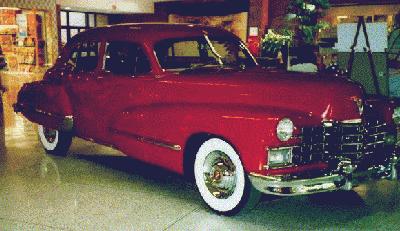
| I. D. NUMBERS |
- Cadillac serial numbers again matched motor numbers and were used for all license, insurance and identification purposes.
- They were placed in the same locations as before.
- Motor serial numbers 5420001 to 5428555 appeared on 1947 Series 61 models.
| Model Number | Body Style | Doors | Model | Seating | Factory Price | Shipping Weight | Production Total |
| 47-61 | 6107 | 2-door | Club Coupe | 5 | 2200 | 4080 | 3,395 |
| 47-61 | 6109 | 4-door | Sedan | 5 | 2324 | 4165 | 5,160 |
| ENGINE |
- V-8 L-head.
- Cast iron block.
- Displacement: 346 cubic inches.
- Bore and stroke: 3-1/2 x 4-1/2 inches.
- Compression ratio: 7.25:1.
- Brake horsepower: 150 at 3400 rpm
- Three main bearings.
- Hydraulic valve lifters.
- Carburetor: Carter WCD two-barrel (models 595S or 595SA) or Stromberg AAV-26 two-barrel (models 380154 or 380871).
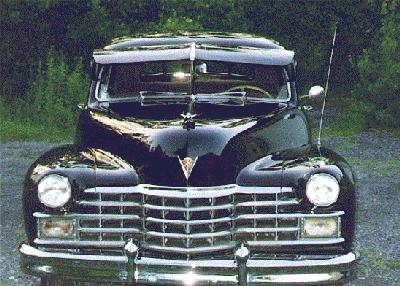
 Series 62 Cadillacs were again based on the GM C-Body and had a slightly sleeker appearance than models in the outer lines. Notchback styling we seen on all models, except the fastback coupe. However, it was easy to distinguish this car from a 61 coupe, as the door skins did not flare-out above the rocker panels; the side window openings were lower and the reveal moldings circled each window individually instead of looping around all windows as on the smaller car. The 62 sedan also had door skins which mated flush with the rocker panels and featured ventipanes on both the front and rear windows. The 62 convertible was the only open-bodied Cadillac available.
Series 62 Cadillacs were again based on the GM C-Body and had a slightly sleeker appearance than models in the outer lines. Notchback styling we seen on all models, except the fastback coupe. However, it was easy to distinguish this car from a 61 coupe, as the door skins did not flare-out above the rocker panels; the side window openings were lower and the reveal moldings circled each window individually instead of looping around all windows as on the smaller car. The 62 sedan also had door skins which mated flush with the rocker panels and featured ventipanes on both the front and rear windows. The 62 convertible was the only open-bodied Cadillac available. | I. D. NUMBERS |
- Motor serial numbers 8420001 to 8459835 appeared on 1947 Series 62 models.
| Model Number | Body Style | Doors | Model | Seating | Factory Price | Shipping Weight | Production Total |
| 47-62 | 6207 | 2-door | Club Coupe | 5 | 2446 | 4145 | 7,245 |
| 47-62 | 6267 | 2-door | Convertible Coupe | 5 | 2902 | 4455 | 6,755 |
| 47-62 | 6269 | 4-door | Sedan | 5 | 2523 | 4235 | 25,834 |
| 47-62 | - | - | Chassis only | - | - | - | 1 |
| ENGINE |
- V-8 L-head.
- Cast iron block.
- Displacement: 346 cubic inches.
- Bore and stroke: 3-1/2 x 4-1/2 inches.
- Compression ratio: 7.25:1.
- Brake horsepower: 150 at 3400 rpm
- Three main bearings.
- Hydraulic valve lifters.
- Carburetor: Carter WCD two-barrel (models 595S or 595SA) or Stromberg AAV-26 two-barrel (models 380154 or 380871).
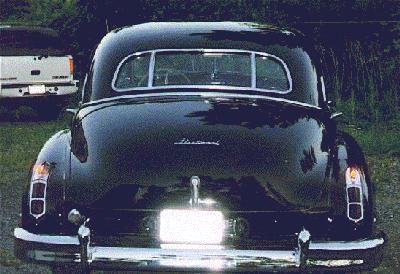
| SERIES 60 SPECIAL FLEETWOOD |
Two-inch wider doors were again seen on the Series 60 Special Fleetwood line, giving this car a custom look, as compared to standard Series 62 sedans based on the same GM C-Body shell. A heavy upper beltline molding, individual window loop moldings, and four slanting louvers on the rear roof pillar were identification features as was the new Fleetwood trunk ornament, which varied from that seen on lower models. Bright metal stone guards were adopted this season and skirted rear fenders were used again.
| I. D. NUMBERS |
- Motor serial numbers 6420001 to 6428500 appeared on 1947 series 60S models.
| Model Number | Body Style | Doors | Model | Seating | Factory Price | Shipping Weight | Production Total |
| 47-60 | 6069 | 4-door | Sedan | 6 | 3195 | 4370 | 8,500 |
| ENGINE |
- V-8 L-head.
- Cast iron block.
- Displacement: 346 cubic inches.
- Bore and stroke: 3-1/2 x 4-1/2 inches.
- Compression ratio: 7.25:1.
- Brake horsepower: 150 at 3400 rpm
- Three main bearings.
- Hydraulic valve lifters.
- Carburetor: Carter WCD two-barrel (models 595S or 595SA) or Stromberg AAV-26 two-barrel (models 380154 or 380871).
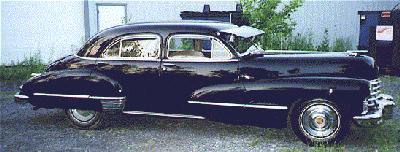
| SERIES 75 FLEETWOOD |
Unchanged in all but minor details for 1947, the big Fleetwood 75 series continued to use the touring sedan body with a stately, pre-war appearance. It came in the same five configurations marketed the year before and had the same assortment of standard equipment geared to the luxury class buyer.
| I. D. NUMBER |
- Motor serial numbers 3420001 to 3425036 appeared on 1947 series 75 models.
| Model Number | Body Style | Doors | Model | Seating | Factory Price | Shipping Weight | Production Total |
| 47-75 | 7519 | 4-door | Sedan | 5 | 4340 | 4875 | 300 |
| 47-75 | 7523 | 4-door | Sedan | 7 | 4517 | 4895 | 890 |
| 47-75 | 7523L | 4-door | Business Sedan | 9 | 4195 | 4790 | 135 |
| 47-75 | 7533-L | - | Imperial Business Sedan | 9 | 4388 | 4800 | 80 |
| 47-75 | 7533 | - | Imperial Sedan | 7 | 4711 | 4930 | 1,005 |
| 47-75 | - | - | Chassis only | - | - | - | 3 |
| 47-75 | - | - | Commercial Chassis | - | - | - | 2,423 |
| 47-75 | - | - | Business Chassis | - | - | - | 200 |
Note: The Commercial Chassis and Business Chassis featured a 163 inch wheelbase.
| ENGINE |
- V-8 L-head.
- Cast iron block.
- Displacement: 346 cubic inches.
- Bore and stroke: 3-1/2 x 4-1/2 inches.
- Compression ratio: 7.25:1.
- Brake horsepower: 150 at 3400 rpm
- Three main bearings.
- Hydraulic valve lifters.
- Carburetor: Carter WCD two-barrel (models 595S or 595SA) or Stromberg AAV-26 two-barrel (models 380154 or 380871).
| CHASSIS |
| Model | Wheelbase | Overall Length | Front Tread | Rear Tread | Tires |
| Series 61 | 126 inches | 215 inches | 59 inches | 63 inches | 7.00 x 15 |
| Series 62 | 129 inches | 220 inches | 59 inches | 63 inches | 7.00 x 15 |
| Series 60S | 133 inches | 224 inches | 59 inches | 63 inches | 7.00 x 15 |
| Series 75 | 136 inches | 226 inches | 59 inches | 63 inches | 7.50 x 16 |
| POWER TRAIN OPTIONS |
- None available
| CONVENIENCE OPTIONS |
- Hydra-Matic transmission ($186)
- Large wheel discs ($25).
- White sidewall discs.
- Fog lights.
- Safety spotlight.
- Fender mounted radio antenna.
- And more.
| HISTORICAL |
- Division windows between front and rear windows were available on some Fleetwood models for limousine use.
- Commercial and business chassis were provided to Professional car makers.
- The Classic Car Club of America recognizes all 1947 Series 75 models as classic cars.
1946 Cadillac
- Details
- Written by Big Block
- Category: 1940-1949
- Hits: 4149
1946 Cadillac
Ending a hurried production run that had begun four years earlier, just after Pearl Harbor, the last M-24 tank rolled off the Cadillac assembly line on August 24, 1945. Amazingly, the first '46 Caddy was produced on October 7, 1945.
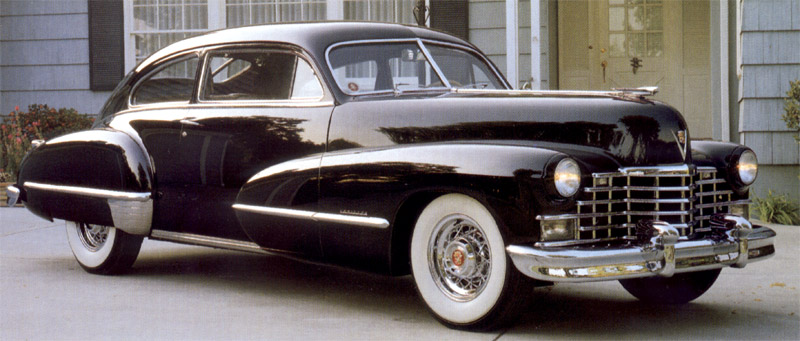
By necessity, the '46 Cadillac was a quickly thrown-together rehash of what Cadillac had offered in 1942, and only Series Sixty-Two four-door sedans were built at first. Cadillac ads made much of the fact that their "Battle-Proved" engines and transmissions were the only automotive components continually produced without interruption during the war, and improved along the way to boot. A major modification, however, was the adoption of a negative battery ground.

Styling changes were minimal, though noticeable. Rectangular parking lights resided on the upper portion of the slightly modified grille (with fewer vertical bars), and wraparound bumpers were adopted front and rear. The front of the hood and the deck lid now sported the Cadillac crest nestled in a "V," which would become a long-standing trademark, so the Cadillac block lettering was moved to the front fenders.
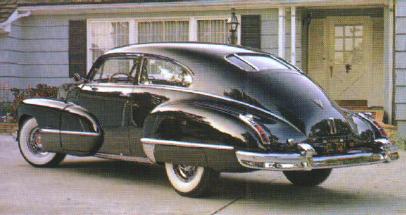
Model offerings were pared to just 11 for 1946. Gone entirely were the Series Sixty-Three and Sixty-Seven, while the Sixty Special lost its division-window model, as well as the vertical chrome strips on the fenders. The latter were replaced by five hash marks on each C-pillar. Series Sixty-One and Sixty-Two continued with the coupe and sedan, and the later boasted the only convertible in the lineup as since 1941. The Series Seventy-Five, meanwhile, was pared to five models, down three, although five-, seven-, and nine-passenger models were still listed, as were the Imperial models with divider windows. Seventy-Fives traded the hood louver decorations and triple fender speed lines of '42 for an almost full-length chrome strip starting at the front of the hood, and gained stainless steel running boards. Cadillac block lettering was moved to the lower front fenders.
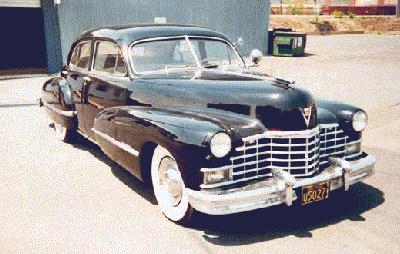
Strikes and materials shortages, particularly of sheet steel, were major industry-wide problems during the '46 production year. Thus, some Cadillac’s went through the assembly lines with only brackets to hold temporary wooden bumpers -- the real ones had to be installed by dealers as they became available later.
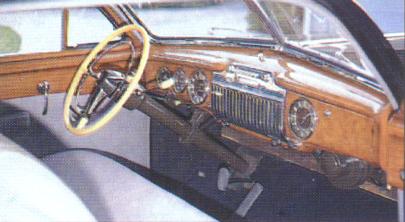
Pressure on Cadillac to produce was intense. Even in 1947, there were still almost 100,000 unfilled orders for what one division sales manager, D. E. Ahrens, called "... one of the most sought-after, and most scarce items in the world today." People knew Cadillac's value and prestige, and that was what they wanted, but due to the early postwar difficulties only 29,214 customers got to drive a '46 Caddy home.
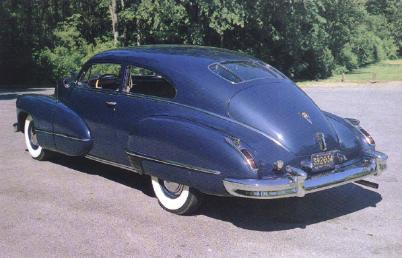
And those that managed to get one paid for the privilege, as the price-leader Sixty-One fastback now started at $2052, up a whopping 41.5 percent over 1942. The Business Imperial nine-passenger sedan, the most expensive 1946 offering, listed at $4346, up $1266, or 41.1 percent. Of course, pricing was a problem for all automakers in the inflationary days following the war.
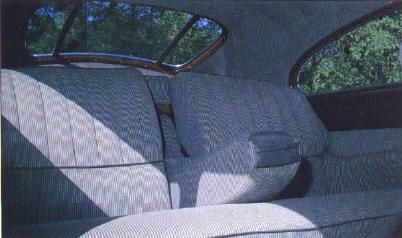
In 1946 four models were offered: Series 61, Series 62, Series 60 Special Fleetwood, and Series 75 Fleetwood.
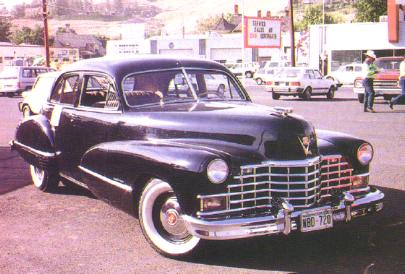
SERIES 61 |
All 1946 Cadillac’s were a continuation of pre-war styling and engineering with the unpopular 63 and 67 Series being dropped. Features common to each series included:
- dual downdraft carburetors;
- torbend disc clutch;
- directional signals;
- knee action wheels;
- double ride stabilizers;
- permanently lubricated universals;
- ball bearing steering;
- mechanical fuel pump;
- oil bath air cleaner;
- intake silencer;
- automatic choke;
- Synchromesh transmission;
- sealed beam lighting;
- front coil springs;
- Super-Safe hydraulic brakes;
- wax lubricated rear springs;
- hypoid rear axle;
- slotted disc wheels;
- low pressure tires;
- large luggage compartments
- safety plate glass throughout.
Cadillac's lowest-priced Series 61 line was based on the General Motors' B-Body, also used on cars in the Buick 40, Olds 70 and Pontiac 26 and 28 series. Fastback styling characterized the two available body styles which saw a late production startup in May, 1946. Standard features included
- small hub caps;
- a wider, more massive grille;
- bullet-shaped front and rear fenders;
- skirted rear wheel openings
- chrome-plated rear fins.
The gas filler cap was located under the rear signal lamp.
I. D. NUMBERS |
- Cadillac serial numbers matched the motor numbers and were used for all license, insurance and identification purposes.
- For 1946 they were located on the right hand side of the engine crankcase, just above the water pump, and on the right frame side member, behind the motor support.
- Numbers 5400001 to 5402975 appeared on Series 61 models.
Model Number | Body Style | Doors | Model | Seating | Factory Price | Shipping Weight | Production Total |
| 46-61 | 6107 | 2-door | Club Coupe | 5 | $2052 | 4145 | 800 |
| 46-61 | 6109 | 4-door | Sedan | 5 | 2176 | 4225 | 2,200 |
| 46-61 | - | - | Chassis only | - | - | - | 1 |
ENGINE |
- V-8 L-head.
- Cast iron block.
- Displacement: 346 cubic inches.
- Bore and stroke: 3-1/2 x 4-1/2 inches.
- Compression ratio: 7.25:1.
- Brake horsepower: 150 at 3400 rpm
- Three main bearings.
- Hydraulic valve lifters.
- Carburetor: Carter WCD two-barrel (models 595S or 595SA) or Stromberg AAV-26 two-barrel (models 380154 or 380871).
The Series 62 Cadillac’s were based on the General Motors C-Body, also used on the Cadillac 60S, Buick 50 and 70 and Oldsmobile 90 series. Notchback styling characterized the racy-looking cars in this line except for the Club Coupe, which had fastback styling. The Series 62 four-door sedan was the first Cadillac to enter production after WWII. Styling and technical features were similar to those seen on lower priced models, but on a longer chassis with slightly richer interior appointments.
I. D. NUMBERS |
- Motor serial numbers 8400001 to 8418566 appeared on 1946 models.
Model Number | Body Style | Doors | Model | Seating | Factory Price | Shipping Weight | Production Total |
| 46-62 | 6207 | 2-door | Club Coupe | 5 | 2284 | 4215 | 2,323 |
| 46-62 | 6267D | 2-door | Convertible Coupe | 5 | 2556 | 4475 | 1,342 |
| 46-62 | 6269 | 4-door | Sedan | 5 | 2359 | 4295 | 14,900 |
| 46-62 | - | - | Chassis only | - | - | - | 1 |
ENGINE |
- V-8 L-head.
- Cast iron block.
- Displacement: 346 cubic inches.
- Bore and stroke: 3-1/2 x 4-1/2 inches.
- Compression ratio: 7.25:1.
- Brake horsepower: 150 at 3400 rpm
- Three main bearings.
- Hydraulic valve lifters.
- Carburetor: Carter WCD two-barrel (models 595S or 595SA) or Stromberg AAV-26 two-barrel (models 380154 or 380871).
The Series 60 Special Fleetwood line included only one model, a four-door sedan also based on the corporate C-Body. However, each door was made two inches wider, amounting to an overall four inch extension over the standard Series 62 sedan. For easy identification, there were four slanting louvers on the rear roof pillar and a distinctive type of roof drip molding, which was separate for each door opening.
I. D. NUMBERS |
- Motor serial number 6400001 to 6405679 appeared on 1946 models.
Model Number | Body Style | Doors | Model | Seating | Factory Price | Shipping Weight | Production Total |
| 46-60S | 6069 | 4-door | Sedan | 6 | 3099 | 4420 | 5,700 |
ENGINE |
- V-8 L-head.
- Cast iron block.
- Displacement: 346 cubic inches.
- Bore and stroke: 3-1/2 x 4-1/2 inches.
- Compression ratio: 7.25:1.
- Brake horsepower: 150 at 3400 rpm
- Three main bearings.
- Hydraulic valve lifters.
- Carburetor: Carter WCD two-barrel (models 595S or 595SA) or Stromberg AAV-26 two-barrel (models 380154 or 380871).
Cadillac's Fleetwood Series 75 long-wheelbase line used totally distinctive bodies which were not shared with other General Motors' divisions. They were generally characterized by a pre-war appearance and came in five different touring sedan configurations: with quarter windows; with auxiliary (jump) seats; business; Imperial 7-passenger and Imperial 9-passenger (the later two both having jump seats). Standard equipment included large wheel discs, fender skirts, hood, side and lower beltline moldings and stainless steel running boards.
I. D. NUMBERS |
- Motor I.D. serial numbers 3400001 to 640579 appeared on 1946 models.
Model Number | Body Style | Doors | Model | Seating | Factory Price | Shipping Weight | Production Total |
| 46-75 | 7519 | 4-door | Sedan | 5 | 4298 | 4860 | 150 |
| 46-75 | 7523 | 4-door | Sedan | 7 | 4475 | 4905 | 225 |
| 46-75 | 7523L | - | Business Sedan | 9 | 4153 | 4920 | 22 |
| 46-75 | 7533L | - | Imperial Business Sedan | 9 | 4346 | 4925 | 17 |
| 46-75 | 7533 | - | Imperial Sedan | 7 | 4669 | 4925 | 221 |
| 46-75 | - | - | Commercial Chassis | - | - | - | 1,292 |
Note: Commercial chassis featured a 163 inch wheelbase.
ENGINE |
- V-8 L-head.
- Cast iron block.
- Displacement: 346 cubic inches.
- Bore and stroke: 3-1/2 x 4-1/2 inches.
- Compression ratio: 7.25:1.
- Brake horsepower: 150 at 3400 rpm
- Three main bearings.
- Hydraulic valve lifters.
- Carburetor: Carter WCD two-barrel (models 595S or 595SA) or Stromberg AAV-26 two-barrel (models 380154 or 380871).
CHASSIS |
Model | Wheelbase | Overall Length | Front Tread | Rear Tread | Tires |
| Series 61 | 126 inches | 215 inches | 59 inches | 63 inches | 7.00 x 15 |
| Series 62 | 129 inches | 220 inches | 59 inches | 63 inches | 7.00 x 15 |
| Series 60S | 133 inches | 224 inches | 59 inches | 63 inches | 7.00 x 15 |
| Series 75 | 136 inches | 227 inches | 59 inches | 63 inches | 7.50 x 16 |
POWER TRAIN OPTIONS |
None available.
CONVENIENCE OPTIONS |
- Hydra-Matic transmission ($176)
- Large wheel discs ($19)
- White sidewall disc
- Fog lights
- Safety spotlight
- And more.
HISTORICAL |
- Division windows between front and rear seats were available on Fleetwood models for limousine use
- Commercial chassis were provided for makers of hearses and ambulances.
- A limited number of dual-cowl phaetons were also constructed on Cadillac chassis this year.
- The Classic Car Club of America recognizes all 1946 Series 75 models as classic cars.
1943 - 1945 Cadillac
- Details
- Written by Big Block
- Category: 1940-1949
- Hits: 2888
1943 - 1945 Cadillac
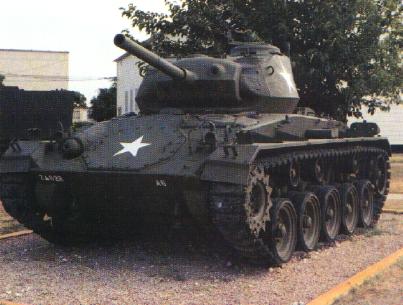 After the abbreviated '42 model run, during which only 16,511 units were produced, Cadillac became a major cog in the wheel of America's war machine. There is much justification for saying that the '43 Cadillac was the highly maneuverable M-24 light tank (sometimes called the M-24 Chaffee) that utilized two Cadillac V-8s and two Hydra-Matic transmissions -- each powering one track of the tank. The two driveline systems were coordinated and connected by a spider gear. Inside each tank, a plaque proudly proclaimed that this was a product of Cadillac. Cadillac Division received the Army-Navy "E" Award for excellence in the production of war equipment. The reliable V-8 engines were also used on the M-19 anti-aircraft gun carriage, and Cadillac engines and transmissions powered the M-5 light tanks, the predecessors of the M-24, as well.
After the abbreviated '42 model run, during which only 16,511 units were produced, Cadillac became a major cog in the wheel of America's war machine. There is much justification for saying that the '43 Cadillac was the highly maneuverable M-24 light tank (sometimes called the M-24 Chaffee) that utilized two Cadillac V-8s and two Hydra-Matic transmissions -- each powering one track of the tank. The two driveline systems were coordinated and connected by a spider gear. Inside each tank, a plaque proudly proclaimed that this was a product of Cadillac. Cadillac Division received the Army-Navy "E" Award for excellence in the production of war equipment. The reliable V-8 engines were also used on the M-19 anti-aircraft gun carriage, and Cadillac engines and transmissions powered the M-5 light tanks, the predecessors of the M-24, as well.
Ironically, Cadillac already had quite a history in warfare and armaments. The Davidson-Cadillac -- capable of a sustained 70 mph when the roads allowed -- was America's first military armored car. Slightly modified Cadillac automobiles had been used in the military action against Pancho Villa in 1916, and Cadillac had been chosen as the standard officer's car by the U.S. Marine Corps in World War I.
Sadly, the founder of Cadillac, Henry Leland, resigned from the company over a squabble with William C. Durant, the pacifist founder of General Motors. Leland had wanted to make aircraft engines during World War I, so after leaving Cadillac he founded the Lincoln Motor Company primarily to build Liberty engines for the war effort. From this, the birth of Cadillac's chief rival was a short step.
There was no such hesitation at Cadillac in World War II. "They shall not want," was the official war slogan of every Cadillac employee.
Again,, more irony. GM's Allison Division was already involved in the production of the formidable Allison aircraft engine before the war. With America's entry into the fray, Cadillac became directly involved in the further design, development, and manufacture of this liquid-cooled engine that was used in P-51s, P-63s, P-39s, and in a plane the Germans called der Gabelschwanz Teufel (the fork-tailed devil), the Lockheed P-38 Lightning. Of course, the lasting irony was that the P-38 was to have a continued impact on Cadillac design long after the war (the '48 tailfins being one example).
Advertising during the war touted the Cadillac drivetrain's contribution to the retreat of the Axis powers. The division's engineering and manufacturing know-how was a major weapon, the ads said, in the Free World's fight against the Nazis and Japan as Cadillac engines and transmissions proved themselves in battle. Perhaps the ads worked a little too well, because after the war some people tried to adapt the military-version units to their cars and other machinery -- often with less than satisfactory results.
When peace returned in 1945, there was a great hunger for cars by returning GI's and a public weary from the protracted war effort. The desire for Cadillac’s was especially strong because many people had had their horizons and expectations widened by the global conflict -- and their pockets deepened by long overtime hours worked during the war. The lengthy Depression that had preceded the war had made the thirst for automobiles even more intense for many. The problem was that there just weren't enough Cadillac’s -- and few cars of any make for that matter -- to be had. Many dealers would take deposits, but filling those orders was another matter.
Ending a hurried production run that had begun four years earlier, just after Pearl Harbor, the last M-24 tank rolled off the Cadillac assembly line on August 24, 1945. Amazingly, the first '46 Caddy was produced on October 7, 1945.
1942 Cadillac
- Details
- Written by Big Block
- Category: 1940-1949
- Hits: 4526
1942 Cadillac
There was a prevailing belief that the '42s were not as well built as the '41s. This wasn't quite true, although the use of lightweight cast-iron pistons instead of aluminum was common. Shoddiness showed up in chrome trim with thin layers of copper and nickel understrikings, or in the inferior grade of plastic that was used everywhere, especially in interior hardware and dashboards. Even the upholstery didn't seem to be quite up to previous standards.
The 1942 Cadillacs were basically similar to '41, but with prices starting at $1450 (up $105) and with longer 129- and 133-‘ch wheelbases for the Series Sixty-Two and Sixty Special, respectively. Body shells were reworked to look rounder and more massive -- it's debatable that they looked any better. Keynotes of Cadillac's facelift were long pontoon fenders that extended into the front doors, a theme repeated on the rear fenders, and a more massive diecast egg-crate grille. After 1942, the Series Sixty-Three and Sixty-Seven were discontinued. Only 16,511 units were built before production switched to M-24 tanks, aircraft engines, and munitions.
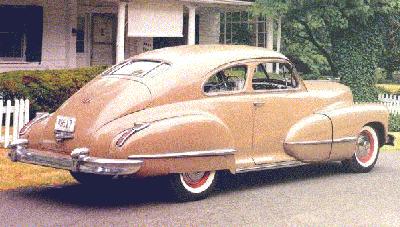
Cadillac entered 1942, its Fortieth Anniversary year, with the same 150-bhp V-8 and six series, but model choices were pared to 22. Gone were the two Sixty-One DeLuxes, the Sixty-Two convertible sedan, and the Sixty Special Town Car. Prices now ranged from $1450 to $4060. The 1942 Cadillac was -- and is -- fairly rare because output was halted on February 41 1942. The U.S. had entered World War II on December 8, just hours after the Japanese bombing of Pearl Harbor, forcing an industry-wide conversion to the manufacture of war materiel. And in fact, the U.S. Office of Production Management had ordered auto production cutbacks back in August 1941, to 73.5 percent of 1940 output.
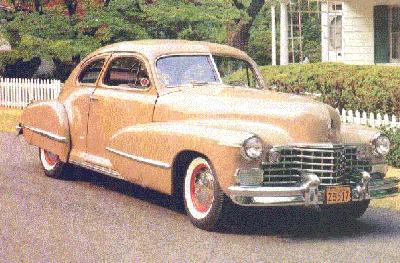
If 1941 was the year of the eggcrate grille at Cadillac, then '42 was the year of the bullet -- or pontoon -- shaped fenders. They caused the '42 design to come across as bulkier, particularly the bulbous front units, which swept rearward well into the doors. This fender treatment had apparently developed in the stylists' minds over several years, for one drawing done at the GM studios as early as 1934 showed the extended fender line explicitly. And, of course, it was seen in production on the '41 Sixty Special, albeit in a more squared-off form.
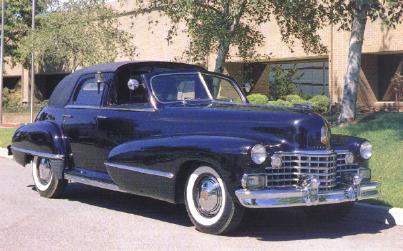
For 1942, Cadillac boasted a wider, bolder eggcrate grille with round parking lights and rectangular fog lamps (when not ordered, fluted chrome caps took their place). Also up front, a seed had been planted that would grow enormously over the years to come, for there on the front bumper was a pair of small (almost embryonic) "Dagmar" bumper extensions. Ed Glowacke would fully develop this design motif in the mid-Fifties.
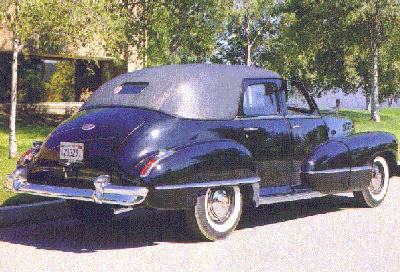
Cadillac advertised its sealed, ribbed Super-Safe brakes and made a point of demonstrating its All-Weather Ventilation System, which allowed an unobstructed flow of air into the car even in the rain. In addition, a T-type parking brake handle was adopted. The Sixty Specials and Sixty-Twos featured a new instrument panel, as well as longer wheelbases: 133 and 129 inches, respectively The Sixty-Two boasted a new fastback coupe, the Sedanet. Looking even more aerodynamic than the Sixty-One fastback, it was easily identified by its longer rear side windows.

The Sixty Special lost some of its uniqueness as Cadillac continued to consolidate its offerings. It now looked much like the regular Cadillacs, with thick center window posts and single chrome spears on all four fenders. The Special, however, sported a series of 14 vertical chrome hash marks on the lower edges of both the front and rear fenders. Fender skirts were standardized across the board.
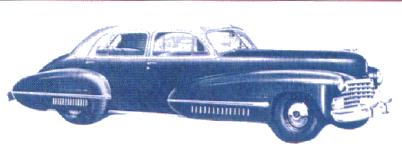
It should be noted that although the Seventy-Fives adopted the new '42 front-end styling, they retained 1941's short, square fenders and triple chrome strips behind the wheels. In fact, they would carry on with the same square-rigged lines through 1949.
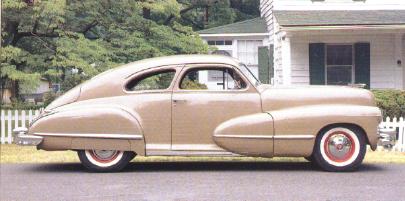
Washington issued "black-out" orders to Cadillac and the rest of the industry on December 31, 1941: no car could be delivered with visible stainless steel trim or chrome, except for bumpers. Metal already chromed or in stainless had to be covered up so that no make would have a sales advantage. Cadillac and the other GM divisions complied by painting the trim in the lighter of their two-tone colors, usually off-white or light gray (some automakers used a thin coat of plastic, most often gray or ivory).
For 1942, the Series lineup remained the same as in 1941.
- The grille became more massive, with fewer bars.
- Parking lights became round and fog light sockets became rectangular and were included within the grille area.
- A bullet shape appeared on the tops of the bumper guard.
- Fenders were rounded and longer.
- Front fenders on all but Series 75 extended into the front doors.
- Series 62 and 60S rear fenders extended forward into rear doors.
- The new fenders had heavy moldings along the sides.
- Series 75 had the new grille but retained the 1941 fender treatment.
- A detail trim change on the 75's was a rounded nose on the hood louvers.
- The first general styling change on the Sixty Special destroyed the character of the car.
- Bulbous lines plus superfluous trim in the form of louver bars on the quarters and numerous short vertical bars low on the fenders spoiled its appeal.
- The only convertible was the Series 62, showing quarter windows for the first time.
- A new fresh air ventilating system with air ducts leading from the grille, replaced cowl ventilators.
- Handbrake control was changed from lever to T-shaped pull handle.
- Radiator shutter control of engine temperature was replaced by a blocking-type thermostat in the water return fitting on the radiator.
| I. D. DATA |
- Serial numbers were on the right frame side bar, just behind the engine support bracket.
- Starting: Same as engine number.
- Ending: Same as engine number.
- Engine numbers were on the right hand side of the crankcase, just above the water pump.
- Engine Numbers on Chrome or polished stainless steel brightwork models
- Series 42A-60S = 6380001 - 6391500
- Series 42A-61 = 5380001 -5385237
- Series 42A-62 = 8380001 - 8384401
- Series 42A-63 = 7380001 - 7381500
- Series 42A-67 = 9380001 -9380520
- Series 42A-75 = 3380001 - 3381200
- Engine Numbers on Painted "brightwork" models
- Series 428-60S = 6386001 - 6386375
- Series 42B-61 = 5386001 - 5386461
- Series 42B-62 = 8386001 - 8386560
- Series 42B-63 = 7386001 - 7386250
- Series 42B-67 = 9386001 - 9386180
- Series 42B-75 = 3386001 - 3386327
| Style Number | Doors | Style | Seating | Price | Weight |
| Fleetwood Series 42-60S, 133" Wheelbase | |||||
| 42-6069 | 4-door | Sedan | - | 2435 | 4310 |
| 42-6069-F | 4-door | Sedan (Div) | - | 2589 | 4365 |
| Fisher Series 42-61, 126" Wheelbase | |||||
| 42-6107 | - | Club Coupe | 5 | 1560 | 4035 |
| 42-6109 | 4-door | Sedan | - | 1647 | 4115 |
| Fisher Series 42-62, 129" Wheelbase | |||||
| 42-6207 | - | Club Coupe | 5 | 1667 | 4105 |
| 42-6207D | - | Opt. Club Coupe | 5 | 1754 | 4125 |
| 42-6269 | 4-door | Sedan | - | 1754 | 4185 |
| 42-6269D | 4-door | Opt. Sedan | - | 1836 | 4205 |
| 42-6267D | - | Optional Convertible Club Coupe | 5 | 2020 | 4365 |
| Fisher Series 42-63, 126" Wheelbase | |||||
| 42-6319 | 4-door | Sedan | - | 1882 | 4115 |
| Fisher Series 42-67, 139" Wheelbase | |||||
| 42-6719 | - | Sedan | 5 | 2896 | 4605 |
| 42-6719-F | - | Sedan (Div) | 5 | 3045 | 4665 |
| 42-6723 | - | Sedan | 7 | 3045 | 4680 |
| 42-6733 | - | Imperial | 7 | 3204 | 4775 |
| Fleetwood Series 42-75, 136" Wheelbase | |||||
| 42-7519 | - | Sedan | 5 | 3306 | 4750 |
| 42-7519-F | - | Sedan (Div) | 5 | 3459 | 4810 |
| -7523 | - | Sedan | 7 | 3459 | 4800 |
| 42-7533 | - | Imperial | 7 | 3613 | 4860 |
| 42-7559 | - | Formal Sedan | 5 | 4330 | 4900 |
| 42-7533-F | - | Formal Sedan | 7 | 4484 | 4915 |
| Business Cars Series 42-75, 136" Wheelbase | |||||
| 42-7523-L | - | Business Sedan | 9 | 3152 | 4750 |
| 42-7533-L | - | Business Imperial | 9 | 3306 | 4810 |
| ENGINE |
- Ninety degree. L-head
- Eight Cylinders
- Cast iron block (blocks cast enbloc with crankcase)
- Bore & Stroke: 3-1/2 in. x 4-1/2 in.
- Displacement: 346 cu. in.
- Compression Ratio: 7.25:1
- Brake Horsepower: 150 @ 3400 rpm
- SAE/Taxable Horsepower: 39.20
- Main bearings: Three
- Valve lifters: Hydraulic.
- Carburetor: Stromberg AAV-26; Carter WDO 486S.
| CHASSIS |
| Series Number | Wheelbase | Overall length | Front Tread | Rear Tread | Tires |
| Series 42-60S | 133 in. | 224 in. | 59 in. | 63 in. | 7.00 x 15 |
| Series 42-61 | 126 in. | 215 in. | 59 in. | 63 in. | 7.00 x 15 |
| Series 42-62 | 129 in. | 220 in. | 59 in. | 63 in. | 7.00 x 15 |
| Series 42-63 | 126 in. | 215 in. | 59 in. | 63 in. | 7.00 x 15 |
| Series 42-67 | 139 in. | 228 in. | 58-1/2 in. | 62-1/2 in. | 7.50 x 16 |
| Series 42-75 | 136 in. | 227 in. | 58-1/2 in. | 62-1/2 in. | 7.50 x 16 |
| Series 42-75 Commercial Chassis | 163 in. | 253-1/32 in. | - | - | 7.50 x 16 |
| TECHNICAL |
- Selective synchro manual transmission.
- Speeds: 3 Forward, 1 Reverse
- Left Hand Drive; gearshift on column; handbrake at left, (RHD optional except 60S, 62, 67, 75).
- Single disc clutch.
- Shaft drive Hotchkiss.
- Semi floating rear axle.
- Hypoid gears.
- Overall Ratio:
- 60S, 61, 62, 63 = 3.77:1; (3.36:1 opt)
- 67, 75 = 4.27:1 (3.77:1 opt)
- Hydraulic brakes on four wheels.
- Slotted disc wheels.
- Wheel size: 15 in (16 in. on 67 and 75).
- Drivetrain Options:
- Automatic transmission: $135.00
- Hill-holder (Norol): $12.50
| OPTIONS |
- Radio: $65.00
- Heater: $59.50-65.00
- Seat covers: $9.75/seat
- Spotlight: $19.50
- Fog lights: $24.50
- Backup light: $12.50
- Windshield washer: $8.25
- Wheel discs: $4.00 each
- Trim rings: $1.50 each
| HISTORICAL |
- Introduced: September, 1941.
- Model year sales and production:
- Series 60S: 1875
- Series 61: 5700
- Series 62: 4961
- Series 63: 1750
- Series 67: 700
- Series 75: 1527
- The general manager of Cadillac was Nicholas Dreystadt.
Page 1 of 2